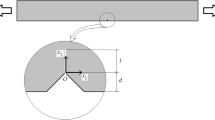Abstract
The purpose of the present work is to account for the influence of residual stresses on the measured fracture toughness of a representative metal-ceramic system and, in conjuction with a maximum hoop stress criterion, to explain the observed increase in toughness with increasing mixity of loading. For the sandwich specimen geometry adopted in the current study, a simple argument yields a critical layer thickness below which residual stress effects are expected to be minimized. The measured fracture toughness is found to be independent of thickness for thicknesses below this threshold. For such specimens a general result is demonstrated: compared to the same loading without residual stresses present, the effect of residual stresses is to decrease the magnitude of the phase angle of the stresses which develop along the interface. It is argued that when small-scale yielding conditions hold, both the mixity and the critical hoop stress corresponding to fracture should be reported at a length which falls within the κ-dominant region in the sample. In this manner, good quantitative agreement between theory and experiment is demonstrated.
Similar content being viewed by others
References
E., Üstündağ, R., Subramanian, R., Dieckmann and S.L., Sass, In Situ Formation of Metal-Ceramic Composites and Ductile Phase Toughned Ceramics by Partial Reduction Reactions, in In-Situ Composites: Science and Technology, M., Singh and D., Lewis (eds.), The Minerals, Metals and Materials Society, Warrendale, PA, (1994) 97–113.
S.A., Jones and J.M., Burlitch, In Situ Formation of Composites with Nickel and With Nickel Aluminide, Materials Letters 19 (1994) 233–235.
F.-S., Shieu, R., Raj and S., Sass, Control of the Mechanical Properties of Metal-Ceramic Interfaces Through Interfacial Reactions, Acta Metallurgica 38 (1990) 2215–2224.
P., Alemany, R.S., Boorse, J.M., Burlitch and R., Hoffmann, Theoretical Study of Transition Metal Adhesion on Doped Al2O3, Chemistry of Materials 5 (1993) 465–471.
N.P., O'Dowd, C.F., Shih and M.G., Stout, Test Geometries for Measuring Interfacial Fracture Toughness, International Journal of Solids and Structures 29 (1992) 571–589.
K.M., Liechti and Y.-M., Liang, The Interfacial Fracture Characteristics of Bimaterial and Sandwich Blister Specimens, International Journal of Fracture 55 (1992) 95–114.
M.E., Thurston, and A.T., Zehnder, Experimental Determination of Silica/Copper Interfacial Fracture Toughness, Acta Metallurgica et Materialia 41 (1993) 2985–2992.
K.M., Liechti and Y.-S., Chai, Biaxial Loading Experiments for Determining Interfacial Fracture Toughness, Journal of Applied Mechanics 58 (1991) 680–687.
M.L., Williams, The Stresses Around a Fault or Crack in Dissimilar Material, Bulletin of the Seismological Society of America 49 (1959) 199–204.
J.R., Rice, Elastic Fracture Mechanics Concepts for Interfacial Cracks, Journal of Applied Mechanics 55 (1988) 98–103.
F.A., Elrefaie and W.W., Smeltzer, Thermodynamics of Ni-Al-O System between 900 and 1400 K, Journal of the Electrochemical Society 128 (1981) 2237–2242.
J., Weertman and P., Shahinian, Transactions AIME 206 (1956) 1223–1230.
H.J., Frost and M.F., Ashby, Deformation Mechanism Maps, Pergammon Press, New York (1982).
M.E. Thurston, Influence of Residual Stresses on Ceramic-Metal Interfacial Toughness, Ph.D. thesis, Cornell University (1994).
O.C., Zienkiewicz and J.Z., Zhu, The Superconvergent Patch Recovery and A Posteriori Error Estimates. Part 1: The Recovery Technique, International Journal of Numerical Methods in Engineering 36 (1993) 2703–2724.
Author information
Authors and Affiliations
Rights and permissions
About this article
Cite this article
Thurston, M.E., Zehnder, A.T. Nickel-alumina interfacial fracture toughness: experiments and analysis of residual stress effects. Int J Fract 76, 221–241 (1996). https://doi.org/10.1007/BF00048288
Received:
Accepted:
Published:
Issue Date:
DOI: https://doi.org/10.1007/BF00048288




